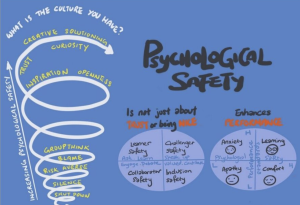For the last few years, a new (and important) workplace concept has started to gain popular currency – the notion that workplaces need to be ‘psychologically safe.’
The concept is an extension of traditional concept of ‘health and safety’ – which tends to look at the things that might cause accidents, and instead looks at what are the ‘psychosocial risks’ of the workplace – that is the very way work is actually organized (defined as everything from social factors at work, to aspects of the work environment), and the risk it presents.
As one commentator recently put it: “If staff are fish in a pond and they’re all getting ill, getting them to be more resilient isn’t the answer, because it’s the water that’s toxic,” he said. He added: “The answer that’s needed is an approach that looks at the environment these people – fish – are swimming in, and what systems are in place to support them.”
To bring this to a practical level, good psychological safety can best be explained by it being experienced as a ‘feeling’. It stems from a shared belief, held by members of a team, that the workplace is a safe place to speak up in without getting into trouble.
As Professor Amy Edmondson, the American scholar of leadership, teaming, and current professor of leadership at Harvard Business School, describes it, psychological safety is “permission for candor.” In the workplace, it is the perception employees have of the likely consequences of taking a personal risk.
Good psychological safety sees teams work at their best
Professor Edmondson’s research shows that psychological safety creates an environment for teams to perform at their best.
Where good psychological safety exists, concerns are raised and addressed, mistakes are shared and learned from, and there is curiosity. It’s questions that are asked rather than accusations thrown.
The result is that teams get better over time, and the opportunity for learning leads to increased levels of innovation and performance.

Source: www.visibledynamics.co.uk/measure-psychological-safety
Leadership is essential
But it’s the emotional Intelligence in leaders that can make or break levels of psychological safety in the workplace.
Leaders who create an environment where their teams speak out, without fear of recrimination, judgement or being ignored, will enhance performance.
As a result, leaders that demonstrate high levels of EI are highly sought after, and for good reason.
There have been some high-profile examples where psychological safety has been lacking in the workplace. As a result, it had a significant and damaging effect on brand and company reputation – and most importantly loss of life.
In 2018-2019, hundreds of lives were lost and Boeing experienced catastrophic damage to its brand following two aircraft crashes.
Inquiries revealed a lack of psychological safety within the organization.
Engineers were pushed to prioritize an overly-ambitious production schedule and were fearful of losing their jobs should they raise concerns about safety-critical issues.
But having a whistleblowing policy is not enough to help tackle employee’s fear of retribution if psychological safety doesn’t exist to support it.
So, how is it possible to create the conditions for psychological safety to flourish?
While it requires a collaborative team effort, leaders play a significant role in creating a climate that supports psychological safety.
This is where effective emotional intelligence comes in.
It requires leaders to set the tone for interactions within the team.
This means putting egos aside, having a positive regard for and interest in others, and taking steps to be aware of what people are thinking and feeling.
By actively facilitating discussions with their teams, leaders can encourage people to voice their unique perspectives.
Diversity of thought allows the team to innovate, grow and learn.
Psychological safety is not about people moaning
Amongst leaders who have already established effective and emotionally intelligent habits, promoting psychological safety may feel easy.
For others, they may ask this obvious question: won’t this just lead to people moaning all the time?
But it’s important to understand that a psychologically safe culture is not the same as letting people say whatever they like, however they like. Mutual respect is key.
Equally, it’s not about being overly nice, or always making others feel comfortable.
Ultimately it is about getting the best out of people by creating a culture of trust to discuss and overcome challenges, while maintaining high standards and enabling people to hold each other to account.
All these things about can be developed by using a three-part strategy to build psychological safety:
Signal positive intent
Leaders should frame and signal their intention during discussions, being explicit about the purpose behind a message.
For example, this can include specifically stating the benefit intended for team learning and development of ideas. Signals can also be non-verbal, so leaders should be mindfully aware of how they are behaving and how this could be perceived by others. Being clear in communicating positive intention is important because it invites others to relax, to be open to the message, and less likely to be defensive.
Show interpersonal sensitivity
When leaders become more aware of their behavior, they have a better understanding of how it impacts others.
Tone of voice, attitude, expression and non-verbal cues all play a part in understanding and communicating with others.
This self-awareness needs to be matched by an awareness of others. Leaders should pay attention to what is going on for people emotionally. They must be curious about their perspective and show empathy.
This will encourage people to let their guard down, speak freely and display a degree of vulnerability. No one has all the answers, and collaboration, sharing of ideas and an understanding of some of the pressures others face at work (and at home), all help build trust.
Learn without judgement
Finally, leaders must be prepared to listen, and seek to learn from people’s differences and opinions, without judgement.
This means focusing on the potential for learning and improvement, and separating the person from the problem. This leads to feedback which is accepted with curiosity.
To develop a learning culture within a team, a leader can encourage themselves and others to focus on solutions and ways forward, rather than attribute blame.
Remember: in a psychologically safe culture, ideas and differences lead to innovation and progress, and learning enables better results.
By taking steps to build emotional intelligence in the leadership and wider team, psychological safety becomes easier to develop and sustain over the longer term.
Teams are complex, and so of course, there will always be setbacks.
But by applying the three strategies proactively – including when the going gets tough – it is possible to get back on track, learn, and achieve together.
